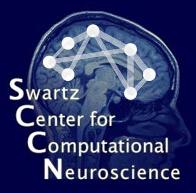|
Two tasks alternated: a categorization task and a recognition task. In both tasks, target images and non-target images were
equally likely presented. Participants were tested in two recording phases. The first day was composed of 13 series, the second
day of 12 series, with 100 images per series (see details of the series below). To start a series, subjects had to press a
touch-sensitive button. A small fixation point (smaller than 0.1° of visual angle) was drawn in the middle of a black screen.
Then, an 8 bit color vertical photograph (256 pixels wide by 384 pixels high which roughly correspond to 4.5° of visual angle
in width and 6.5° in height) was flashed for 20 ms (2 frames of a 100 Hz SVGA screen) using a programmable graphic board (VSG
2.1, Cambridge Research Systems). This short presentation time avoid that subjects use exploratory eye movement to respond.
Participants gave their responses following a go/nogo paradigm. For each target, they had to lift their finger from the button
as quickly and accurately as possible (releasing the button restored a focused light beam between an optic fiber led and its
receiver; the response latency of this apparatus was under 1 ms). Participants were given 1000 ms to respond, after what any
response was considered as a nogo response. The stimulus onset asynchrony (SOA) was 2000 ms plus or minus a random delay of
200 ms. For each distractor, participants had to keep pressing the button during at least 1000 ms (nogo response).
More specifically, in the animal categorization task, participants had to respond whenever there was an animal in the picture.
In the recognition task, the session started with a learning phase. A probe image was flashed 15 times during 20 ms intermixed
with two presentations of 1000 ms after the fifth and the tenth flashes, allowing an ocular exploration of the image; with
an inter-stimulus of 1000 ms. Participants were instructed to carefully examine and learn the probe image in order to recognize
it in the following series. The test phase started immediately after the learning phase. The probe image constituted the unique
target of the series. Both tasks were organized in series of 100 images; 50 targets images were mixed with 50 non-targets
in the animal categorization task; 50 copies of an unique photographs were mixed at random with 50 non-targets in the recognition
task.
The images of each category were chosen to be as varied as possible. The animal category included pictures of mammals, birds,
fishes, arthropods, and reptiles. There was no a priori information about the size, position or number of the targets in a
single photograph. There were also a wide range of non-target images, with outdoor and indoor scenes, natural landscapes or
city scenes, pictures of food, fruits, vegetables, trees and flowers... In the categorization task, 500 distractors and 500
targets were seen by every subject but randomly distributed among all 10 series. In the recognition task, 750 distrators and
210 target photographs were used (15 target photographs per subject).
|
| Description |
Tag |
| Participants seated in a dimly lit room at 110 cm from a computer screen piloted from a PC computer. Participants gave their
responses following a go/no-go paradigm. Participants were given 1000 ms to respond. After 1000ms, any response was considered
as a no-go response.
|
/Context/Sitting,/Context/Screen Distance/1.1, /Paradigm/Go/No-Go,/State/Awake/Under time pressure/Response Window |
| Event Code |
Condition |
| Label |
Description |
Tag |
| 120XX |
Target |
target in the animal categorization task, where XX stands for the trial number 1 to 100 (01-00) |
/Time-Locked Event/Stimulus/Visual,/Time-Locked Event/Stimulus/Target,/Time-Locked Event/Stimulus/Visual/Movie/Natural Scene,/Time-Locked
Event/Response/Hand/Finger/Lift
|
| 121XX |
Target |
target in the "easy" animal recognition task,where XX stands for the trial number 1 to 100 (01-00) |
/Time-Locked Event/Stimulus/Visual,/Time-Locked Event/Stimulus/Target,/Time-Locked Event/Stimulus/Visual/Movie/Natural Scene,/Time-Locked
Event/Response/Hand/Finger/Lift
|
| 122XX |
Target |
target in the "hard" animal recognition task, where XX stands for the trial number 1 to 100 (01-00) |
/Time-Locked Event/Stimulus/Visual,/Time-Locked Event/Stimulus/Target,/Time-Locked Event/Stimulus/Visual/Movie/Natural Scene,/Time-Locked
Event/Response/Hand/Finger/Lift
|
| 123XX |
Target |
target in the non-animal recognition task, where XX stands for the trial number 1 to 100 (01-00) |
/Time-Locked Event/Stimulus/Visual,/Time-Locked Event/Stimulus/Target,/Time-Locked Event/Stimulus/Visual/Movie/Natural Scene,/Time-Locked
Event/Response/Hand/Finger/Lift
|
| 125XX |
Distractor |
distractor in the animal categorization task, where XX stands for the trial number 1 to 100 (01-00) |
/Time-Locked Event/Stimulus/Visual,/Time-Locked Event/Stimulus/Expected/Non-Target,/Time-Locked Event/Stimulus/Visual/Movie/Natural
Scene,/Time-Locked Event/Response/Button Hold
|
| 126XX |
Distractor |
distractor in the "easy" animal recognition task, where XX stands for the trial number 1 to 100 (01-00) |
/Time-Locked Event/Stimulus/Visual,/Time-Locked Event/Stimulus/Expected/Non-Target,/Time-Locked Event/Stimulus/Visual/Movie/Natural
Scene,/Time-Locked Event/Response/Button Hold
|
| 127XX |
Distractor |
distractor in the "hard" animal recognition task, where XX stands for the trial number 1 to 100 (01-00) |
/Time-Locked Event/Stimulus/Visual,/Time-Locked Event/Stimulus/Expected/Non-Target,/Time-Locked Event/Stimulus/Visual/Movie/Natural
Scene,/Time-Locked Event/Response/Button Hold
|
| 128XX |
Distractor |
distractor in the non-animal recognition task, where XX stands for the trial number 1 to 100 (01-00) |
/Time-Locked Event/Stimulus/Visual,/Time-Locked Event/Stimulus/Expected/Non-Target,/Time-Locked Event/Response/Button Hold |
|
The person who associated a work with this deed has dedicated the work to the public domain by waiving all of his or
her rights to the work worldwide under copyright law, including all related and neighboring rights, to the extent allowed
by law. You can copy, modify, distribute and perform the work, even for commercial purposes, all without asking permission.
In no way are the patent or trademark rights of any person affected by CC0, nor are the rights that other persons
may have in the work or in how the work is used, such as publicity or privacy rights.
Unless expressly stated otherwise, the person who associated a work with this deed makes no warranties about the work,
and disclaims liability for all uses of the work, to the fullest extent permitted by applicable law.
When using or citing the work, you should not imply endorsement by the author or the affirmer.
|
